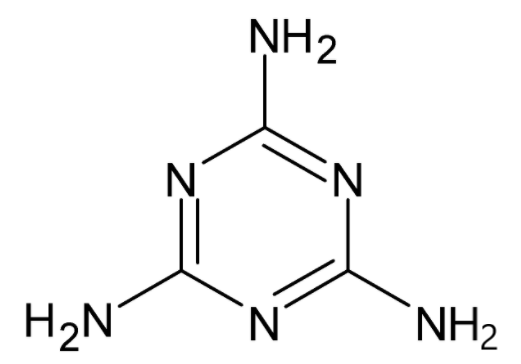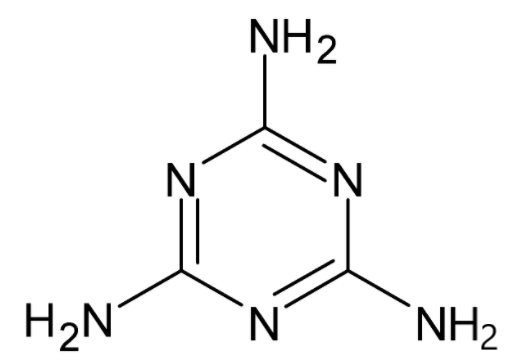
The total number of lone pairs of electrons in melamine is:

A. Three lone pairs from triazine moiety
B. Three lone pairs from ${{ - N}}{{{H}}_2}$ moiety
C. Six lone pairs from all of the ${{N}}$
D. None of these

Answer
451.8k+ views
Hint: Before calculating the number of lone pairs of electrons in the compound, we have to know about the catenation property of the elements in the given compound. Also, we need to know the valency of each element in the compound so that we can understand the number of electrons gained or lost.
Complete step by step answer:
We know that a lone pair of electrons is a pair of electrons which is not bonded with any other atom. Generally, they are present in the valence shell or outermost shell of the atom. They are also termed as non-bonded pairs of electrons. Lewis dot structure is used to find the lone pair of electrons. The structure of melamine is given. Thus the molecular formula of melamine is ${{{C}}_3}{{{H}}_6}{{{N}}_6}$.

Another name for melamine is 1,3,5-triazine. The compound contains carbon, hydrogen and nitrogen atoms. We know that the valencies of carbon, hydrogen and nitrogen are $4,1$ and $5$ respectively, i.e. they have this number of electrons in their valence shell for the bond formation.
In the compound, carbon has satisfied its valency, i.e. it has shared its four valence electrons with hydrogen and nitrogen. Hydrogen also has satisfied its valency. But nitrogen has not satisfied its valency. It has bonded only to three atoms. There is a pair of electrons which is not shared to any other atom. This is known as the lone pair of electrons. All of the nitrogen atoms have a lone pair of electrons. There are a total of six nitrogen atoms. So a total of six lone pairs of electrons are present in the compound.
So the total number of lone pairs of electrons in melamine is six.
Hence, option C is the correct answer.
Note: Melamine can be prepared by reacting urea with cyanuric acid. They have several uses like they have been used as glues, dinnerwares, flame retardants, increase nitrogen content in milk, increase protein content etc.
Complete step by step answer:
We know that a lone pair of electrons is a pair of electrons which is not bonded with any other atom. Generally, they are present in the valence shell or outermost shell of the atom. They are also termed as non-bonded pairs of electrons. Lewis dot structure is used to find the lone pair of electrons. The structure of melamine is given. Thus the molecular formula of melamine is ${{{C}}_3}{{{H}}_6}{{{N}}_6}$.

Another name for melamine is 1,3,5-triazine. The compound contains carbon, hydrogen and nitrogen atoms. We know that the valencies of carbon, hydrogen and nitrogen are $4,1$ and $5$ respectively, i.e. they have this number of electrons in their valence shell for the bond formation.
In the compound, carbon has satisfied its valency, i.e. it has shared its four valence electrons with hydrogen and nitrogen. Hydrogen also has satisfied its valency. But nitrogen has not satisfied its valency. It has bonded only to three atoms. There is a pair of electrons which is not shared to any other atom. This is known as the lone pair of electrons. All of the nitrogen atoms have a lone pair of electrons. There are a total of six nitrogen atoms. So a total of six lone pairs of electrons are present in the compound.
So the total number of lone pairs of electrons in melamine is six.
Hence, option C is the correct answer.
Note: Melamine can be prepared by reacting urea with cyanuric acid. They have several uses like they have been used as glues, dinnerwares, flame retardants, increase nitrogen content in milk, increase protein content etc.
Recently Updated Pages
The correct geometry and hybridization for XeF4 are class 11 chemistry CBSE

Water softening by Clarks process uses ACalcium bicarbonate class 11 chemistry CBSE

With reference to graphite and diamond which of the class 11 chemistry CBSE

A certain household has consumed 250 units of energy class 11 physics CBSE

The lightest metal known is A beryllium B lithium C class 11 chemistry CBSE

What is the formula mass of the iodine molecule class 11 chemistry CBSE

Trending doubts
The reservoir of dam is called Govind Sagar A Jayakwadi class 11 social science CBSE

What problem did Carter face when he reached the mummy class 11 english CBSE

Proton was discovered by A Thomson B Rutherford C Chadwick class 11 chemistry CBSE

In China rose the flowers are A Zygomorphic epigynous class 11 biology CBSE

What is Environment class 11 chemistry CBSE

Nucleolus is present in which part of the cell class 11 biology CBSE




